Palo Alto Networks Bundle
Decoding Palo Alto Networks: How Does This Cybersecurity Giant Operate?
In an era defined by relentless cyber threats, Palo Alto Networks SWOT Analysis is at the forefront of digital defense, but how does this cybersecurity company truly work? With a staggering $6.89 billion in revenue in fiscal year 2023, the company's growth trajectory is undeniable. This comprehensive guide delves into the inner workings of Palo Alto Networks, exploring its innovative approach to network security and its impact on the global landscape.
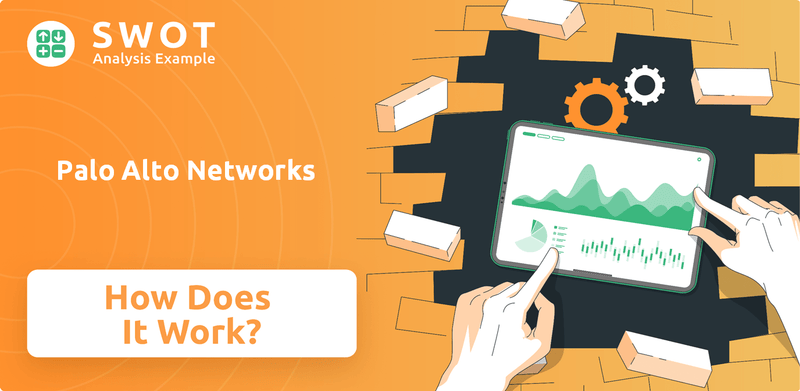
This deep dive into Palo Alto Networks will explore its core products and services, including its renowned next-generation firewall and cloud security solutions. We'll examine how Palo Alto security protects businesses and governments, analyzing its competitive advantages and its strategic direction. Understanding the company's business model is crucial for investors, customers, and industry observers seeking to navigate the complexities of the cybersecurity market, and how its products and services are used to prevent data loss prevention and incident response.
What Are the Key Operations Driving Palo Alto Networks’s Success?
The core of Palo Alto Networks' operations revolves around delivering a unified cybersecurity platform. This platform is designed to protect organizations across their entire digital landscape. The company's value proposition centers on providing comprehensive security solutions that address the evolving threat landscape, with a focus on network security, cloud security, and security operations.
Palo Alto Networks (PANW) creates value by offering a suite of cybersecurity products and services. These are designed to protect businesses of all sizes. Their approach is centered on a platform that integrates various security functions. This integration simplifies security management and enhances threat visibility.
The company's operations are structured around three main areas: Strata for network security, Prisma Cloud for cloud security, and Cortex for security operations and automation. These solutions cater to a diverse customer base, including enterprises, service providers, and government entities. They operate across various industries such as financial services, healthcare, and critical infrastructure, providing protection against cyber threats.
The company invests heavily in research and development to stay ahead of cyber threats. This includes the development of proprietary hardware and software, particularly next-generation firewalls. They also integrate technologies through acquisitions to enhance their offerings. This enables them to provide cutting-edge security solutions.
Sales channels include direct sales to large enterprises and a robust channel partner program. This program extends their reach to a wider customer base globally. They also use a tiered support model, professional services, and an extensive online knowledge base. This ensures customers can effectively deploy and manage their security solutions.
Customers benefit from simplified security management, improved threat visibility, and automated responses to attacks. This platform-centric approach reduces the total cost of ownership. It also strengthens an organization's security posture. The integration of different security functions is a key differentiator.
The Unit 42 threat intelligence team provides critical insights into the latest cyber threats. This informs product development and enables proactive defense. This proactive approach helps customers stay ahead of emerging threats. The company's focus on threat intelligence is a key component of its value proposition.
Palo Alto Networks' approach to cybersecurity is unique due to its platform-centric design, which allows for seamless integration across its security offerings. This contrasts with competitors that offer siloed solutions. The company's focus on innovation and its ability to adapt to the changing threat landscape are key to its success. For a deeper understanding of who benefits from these services, consider the Target Market of Palo Alto Networks. In fiscal year 2024, Palo Alto Networks reported total revenue of approximately $7.7 billion, demonstrating strong growth in the cybersecurity market. The company's commitment to innovation and its platform approach have positioned it as a leader in the cybersecurity industry.
Palo Alto Networks distinguishes itself through its unified platform, which integrates various security functions. This contrasts with competitors offering siloed solutions. The company's threat intelligence capabilities, provided by Unit 42, enable proactive defense against emerging cyber threats.
- Platform-Centric Approach: Seamless integration across security offerings.
- Threat Intelligence: Proactive defense with insights from Unit 42.
- Customer Benefits: Simplified management, improved visibility, and automated responses.
- Innovation: Continuous development of next-generation firewalls and cloud security solutions.
Palo Alto Networks SWOT Analysis
- Complete SWOT Breakdown
- Fully Customizable
- Editable in Excel & Word
- Professional Formatting
- Investor-Ready Format
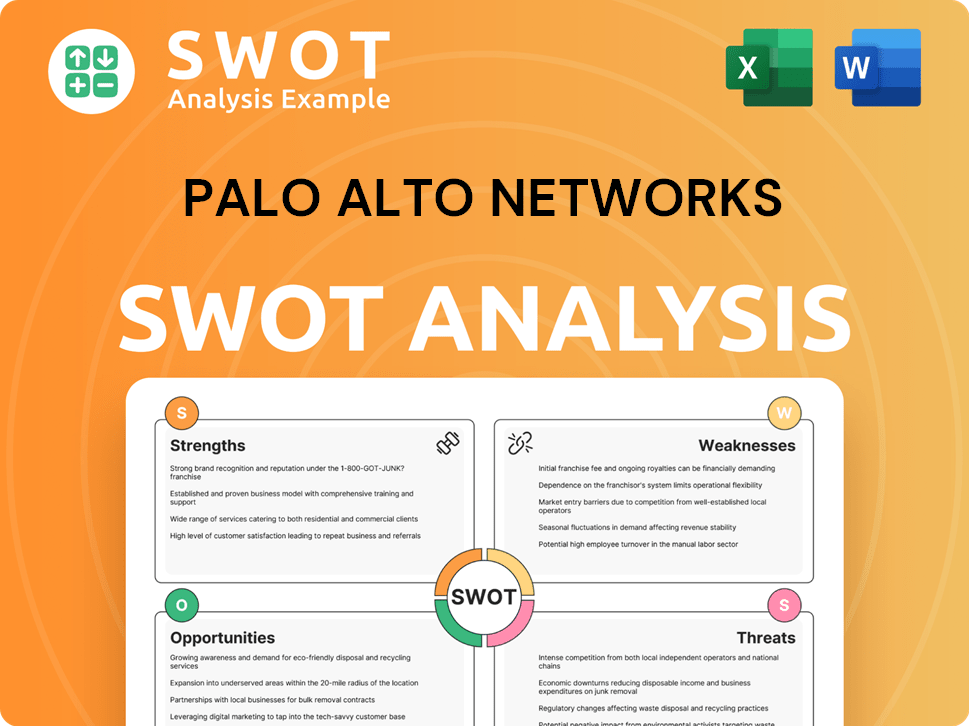
How Does Palo Alto Networks Make Money?
Palo Alto Networks (PANW) generates revenue through a multifaceted approach, primarily focusing on product sales and subscription services. The company's revenue streams are designed to provide both immediate value through hardware and ongoing value through software and support, ensuring a steady and predictable financial performance.
In fiscal year 2023, the company's total revenue reached $6.89 billion. This revenue is divided between product sales and subscription and support services, highlighting the importance of recurring revenue in their business model.
The company's financial strategy emphasizes recurring revenue, which is crucial for long-term stability. This strategy is supported by continuous updates, new features, and expert support, fostering customer loyalty and predictable income.
Product revenue includes sales of next-generation firewall appliances and other hardware. In fiscal year 2023, this segment generated $2.03 billion.
Subscription and support services are a major revenue source. This includes software subscriptions, threat intelligence, and technical support. This segment generated $4.86 billion in fiscal year 2023.
The company offers tiered subscription pricing. This allows customers to select service levels that match their security needs and budget. This flexibility helps attract a broader customer base.
Bundling products and services provides comprehensive security solutions. These integrated suites offer potentially more attractive pricing compared to individual components. This approach encourages customers to adopt a wider range of solutions.
Acquisitions enhance cloud security and automation capabilities. Acquisitions like CloudGenix, Twistlock, and Demisto have expanded the product portfolio. These additions introduce new recurring revenue streams.
Focus on platform consolidation and integrated offerings. This encourages cross-selling, as customers are more likely to integrate additional solutions into their security infrastructure. This approach enhances customer retention and revenue growth.
The company's approach to revenue generation is further detailed in the Marketing Strategy of Palo Alto Networks. This strategy focuses on providing comprehensive security solutions through a combination of product sales and subscription services, ensuring both immediate and long-term value for its customers, which is critical in the dynamic field of cybersecurity.
Palo Alto Networks PESTLE Analysis
- Covers All 6 PESTLE Categories
- No Research Needed – Save Hours of Work
- Built by Experts, Trusted by Consultants
- Instant Download, Ready to Use
- 100% Editable, Fully Customizable
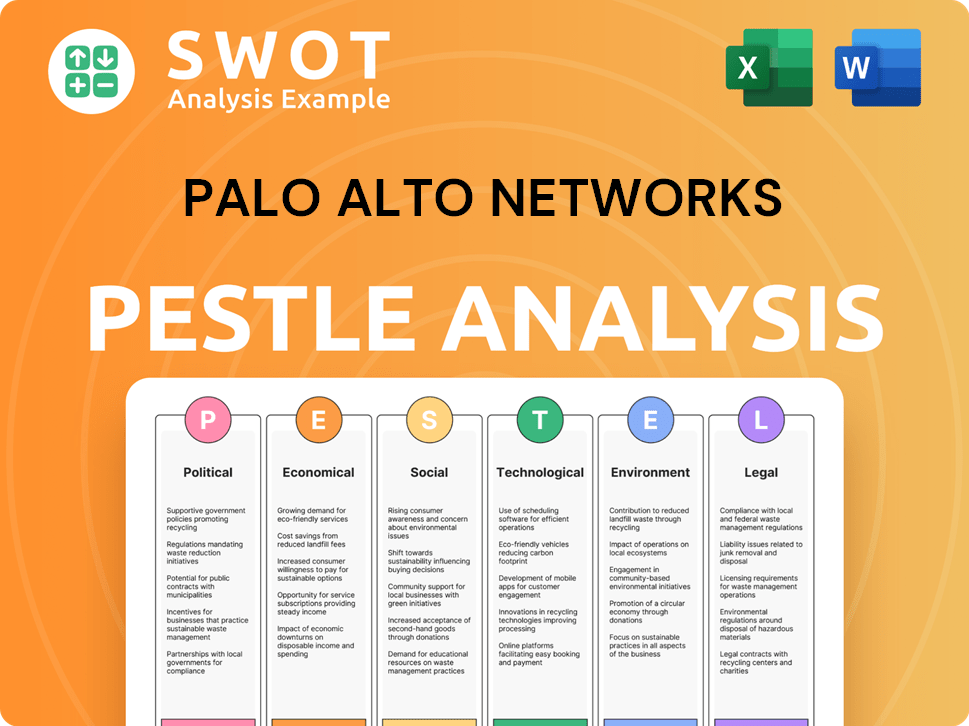
Which Strategic Decisions Have Shaped Palo Alto Networks’s Business Model?
The journey of Palo Alto Networks has been marked by significant milestones and strategic shifts that have shaped its trajectory in the cybersecurity landscape. A key moment was the introduction of its next-generation firewall, which revolutionized network security by providing application-aware visibility and control, moving beyond traditional port-based firewalls. More recently, the company's strategic pivot towards cloud security with Prisma Cloud and security automation with Cortex has been a significant move, aligning with the industry's shift towards cloud-native architectures and automated security operations.
These strategic moves have been largely driven by acquisitions, such as the purchases of Demisto in 2019 for $560 million to enhance security orchestration, automation, and response (SOAR) capabilities, and CloudGenix in 2020 for approximately $420 million to boost its SD-WAN offerings. These acquisitions showcase Palo Alto Networks' commitment to expanding its capabilities and staying ahead of evolving cyber threats. The company's focus on innovation and strategic acquisitions has allowed it to maintain a leading position in the cybersecurity market.
Operational and market challenges have included adapting to the rapid pace of cloud adoption and the increasing sophistication of cyber threats. The company has responded by investing heavily in research and development, as evidenced by its commitment to releasing over 20 new products and modules in 2023. Supply chain disruptions, particularly during the global semiconductor shortages, posed challenges for its hardware business, but the company has worked to diversify its sourcing and optimize its inventory management. Regulatory hurdles, especially concerning data privacy and sovereignty, also require continuous adaptation of its solutions to ensure compliance across different regions.
Palo Alto Networks introduced its next-generation firewall, a pivotal innovation. The company expanded into cloud security with Prisma Cloud. Acquisitions like Demisto and CloudGenix enhanced capabilities.
The company focused on cloud security and security automation. Investments in research and development led to new product releases. Diversification of sourcing and inventory management addressed supply chain issues.
Palo Alto Networks holds a strong brand reputation in cybersecurity. Technology leadership, especially in its next-generation firewall, is a key differentiator. An extensive partner network extends its reach.
Adapting to cloud adoption and sophisticated cyber threats are ongoing challenges. Supply chain disruptions and regulatory hurdles require continuous adaptation. Ensuring compliance across different regions is essential.
Palo Alto Networks' competitive advantages are multi-faceted, including brand strength and technology leadership. The company benefits from an ecosystem effect, where its broad portfolio of integrated products creates customer stickiness. Furthermore, its extensive partner network extends its reach and accelerates adoption.
- Brand Recognition: Globally recognized as a leader in cybersecurity.
- Technology Leadership: Strong in next-generation firewall technology and threat intelligence.
- Ecosystem Effect: Integrated products create customer loyalty.
- Partner Network: Extensive network for broader market reach.
The company continues to adapt to new trends, such as the rise of generative AI in cybersecurity, by integrating AI-powered features into its products to enhance threat detection and automate responses, thereby sustaining its business model and competitive edge in a dynamic threat landscape. For more insights into the company's financial structure, consider exploring the Owners & Shareholders of Palo Alto Networks.
Palo Alto Networks Business Model Canvas
- Complete 9-Block Business Model Canvas
- Effortlessly Communicate Your Business Strategy
- Investor-Ready BMC Format
- 100% Editable and Customizable
- Clear and Structured Layout
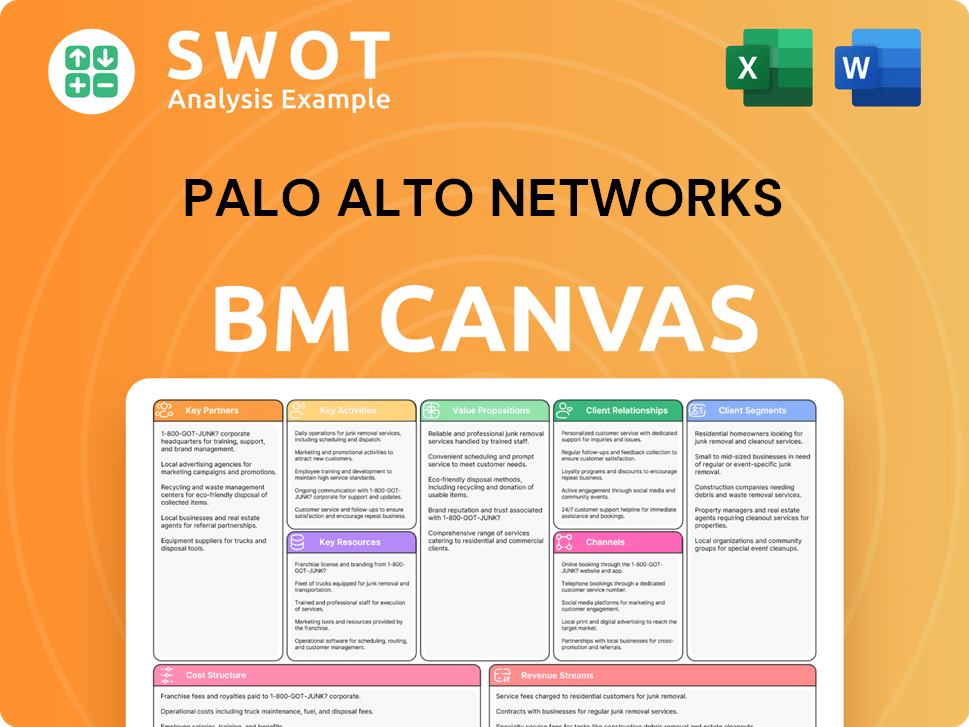
How Is Palo Alto Networks Positioning Itself for Continued Success?
The cybersecurity industry sees Palo Alto Networks as a leading player, especially in network and cloud security. The cybersecurity company often competes with major vendors like Fortinet and CrowdStrike. Its market share in the enterprise firewall sector remains strong, and its expansion into cloud security with Prisma Cloud has boosted its position. Customer loyalty is high due to the comprehensive nature of its platform and its critical role in security infrastructure. The company has a significant global presence, serving customers worldwide.
However, Palo Alto Networks faces risks. Regulatory changes, such as those related to data privacy, could affect its operations. The cybersecurity market is highly competitive, with new technologies constantly emerging. Technological advancements, like quantum computing, could render current solutions less effective. Macroeconomic downturns might also reduce IT spending, impacting sales and renewals. To learn more about the company's strategic direction, you can read about the Growth Strategy of Palo Alto Networks.
Palo Alto Networks holds a strong position in the network security and cloud security markets. It competes with major players like Fortinet and Check Point. The company's firewall market share remains robust, and its cloud security offerings are growing.
Regulatory changes and market competition pose challenges. Technological disruptions, such as advancements in quantum computing, could affect security solutions. Economic downturns could reduce IT spending and impact sales. The company's ability to innovate is crucial.
Palo Alto Networks is focused on platform consolidation and AI integration. The company aims to enhance threat detection and automate security operations. Expansion into cloud security and OT security is a key strategy. They plan to sustain growth through continued innovation.
The company is investing in AI and machine learning for threat detection. They are focused on delivering autonomous security operations. Expansion into cloud security and OT security markets is a priority. The focus is on integrated solutions.
Palo Alto Networks is adapting to the evolving cybersecurity landscape by focusing on platform consolidation and AI-driven solutions. The company is expanding its cloud security offerings and investing in operational technology (OT) security. These initiatives aim to maintain its competitive edge and drive future growth.
- Continued investment in AI and machine learning to enhance threat detection and automate security operations.
- Expansion of cloud security offerings, including Prisma Cloud, to capture a larger share of the cloud security market.
- Deepening presence in the operational technology (OT) security market to address the growing need for securing industrial control systems.
- Integration of advanced AI capabilities across its entire platform to deliver autonomous security operations.
Palo Alto Networks Porter's Five Forces Analysis
- Covers All 5 Competitive Forces in Detail
- Structured for Consultants, Students, and Founders
- 100% Editable in Microsoft Word & Excel
- Instant Digital Download – Use Immediately
- Compatible with Mac & PC – Fully Unlocked
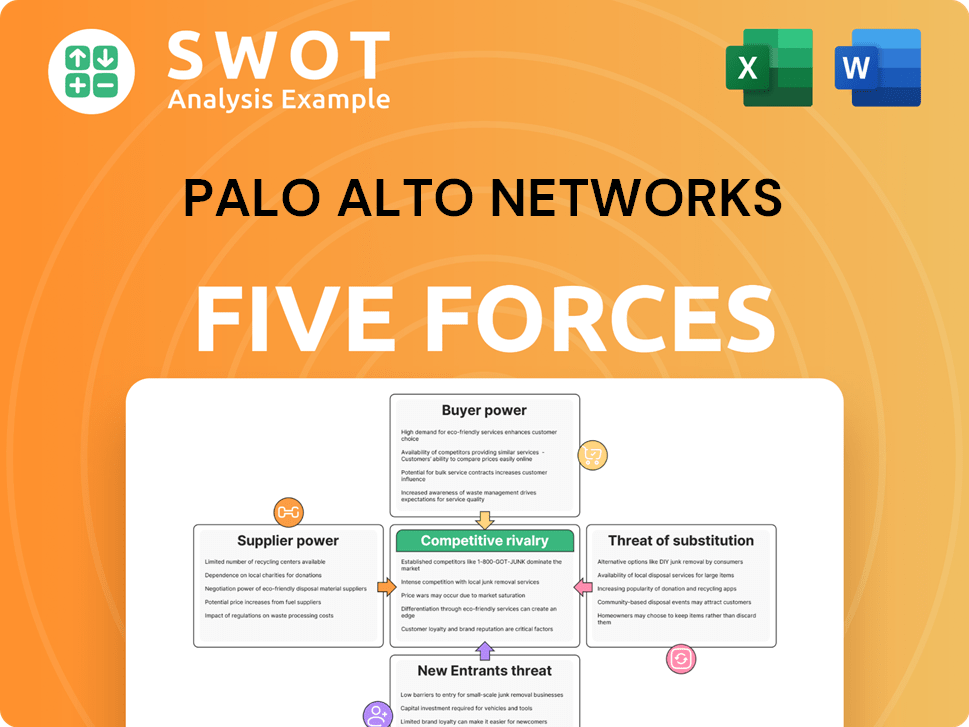
Related Blogs
- What are Mission Vision & Core Values of Palo Alto Networks Company?
- What is Competitive Landscape of Palo Alto Networks Company?
- What is Growth Strategy and Future Prospects of Palo Alto Networks Company?
- What is Sales and Marketing Strategy of Palo Alto Networks Company?
- What is Brief History of Palo Alto Networks Company?
- Who Owns Palo Alto Networks Company?
- What is Customer Demographics and Target Market of Palo Alto Networks Company?
Disclaimer
All information, articles, and product details provided on this website are for general informational and educational purposes only. We do not claim any ownership over, nor do we intend to infringe upon, any trademarks, copyrights, logos, brand names, or other intellectual property mentioned or depicted on this site. Such intellectual property remains the property of its respective owners, and any references here are made solely for identification or informational purposes, without implying any affiliation, endorsement, or partnership.
We make no representations or warranties, express or implied, regarding the accuracy, completeness, or suitability of any content or products presented. Nothing on this website should be construed as legal, tax, investment, financial, medical, or other professional advice. In addition, no part of this site—including articles or product references—constitutes a solicitation, recommendation, endorsement, advertisement, or offer to buy or sell any securities, franchises, or other financial instruments, particularly in jurisdictions where such activity would be unlawful.
All content is of a general nature and may not address the specific circumstances of any individual or entity. It is not a substitute for professional advice or services. Any actions you take based on the information provided here are strictly at your own risk. You accept full responsibility for any decisions or outcomes arising from your use of this website and agree to release us from any liability in connection with your use of, or reliance upon, the content or products found herein.